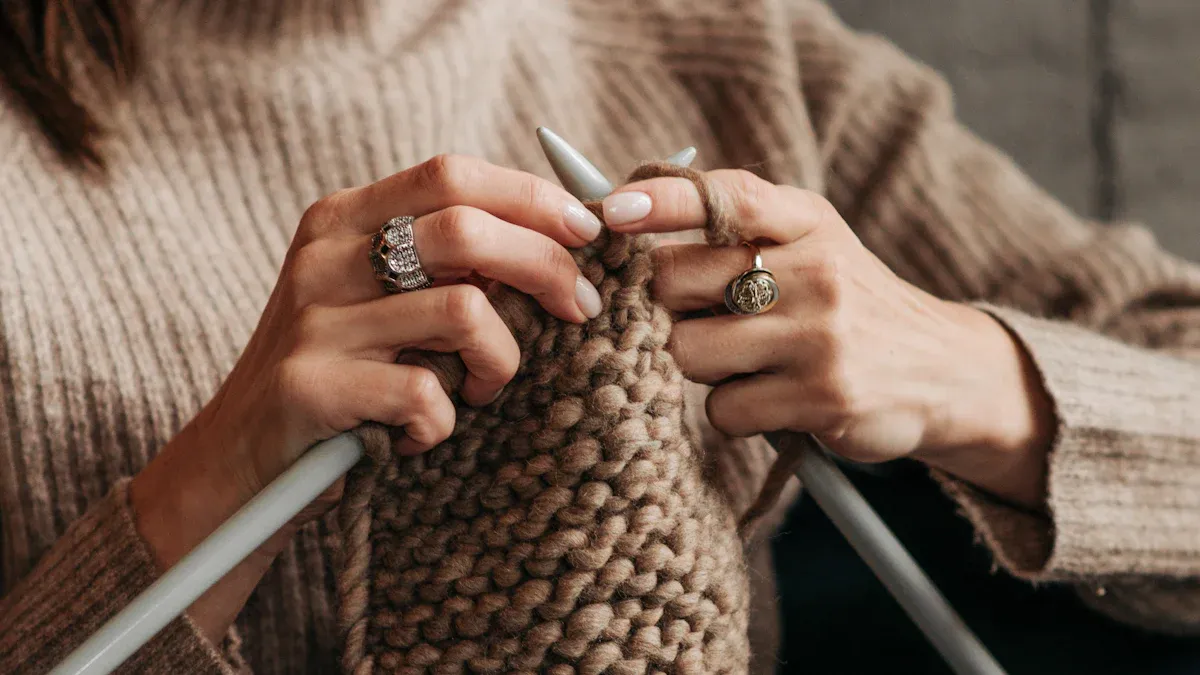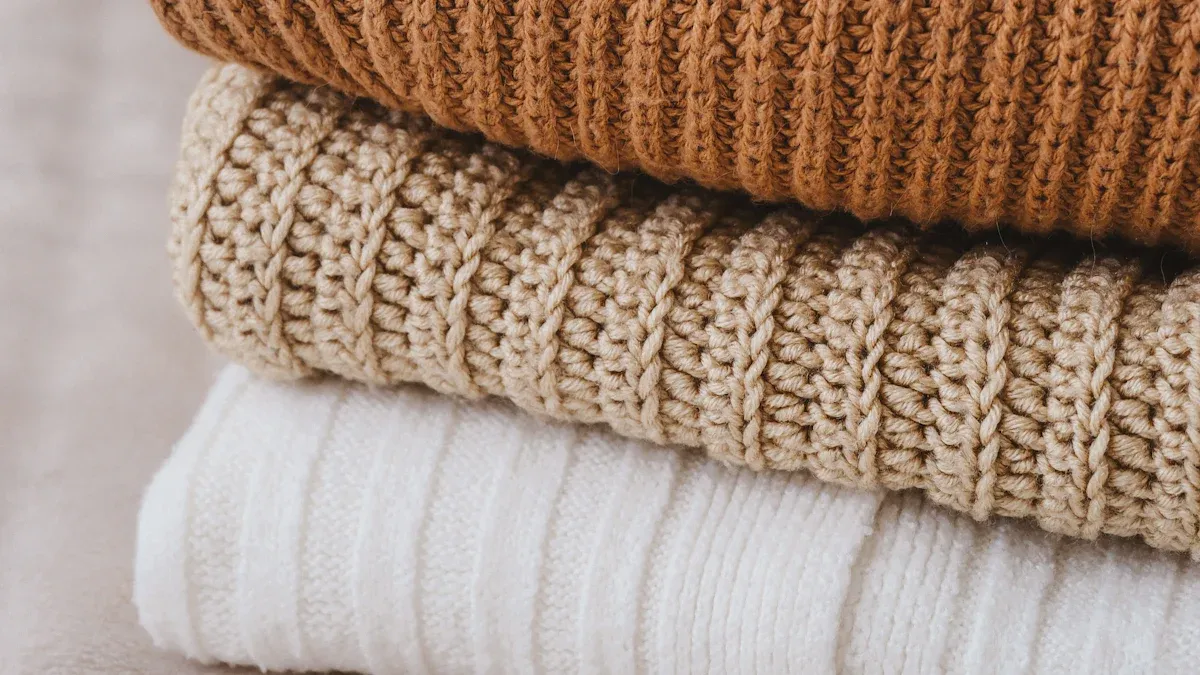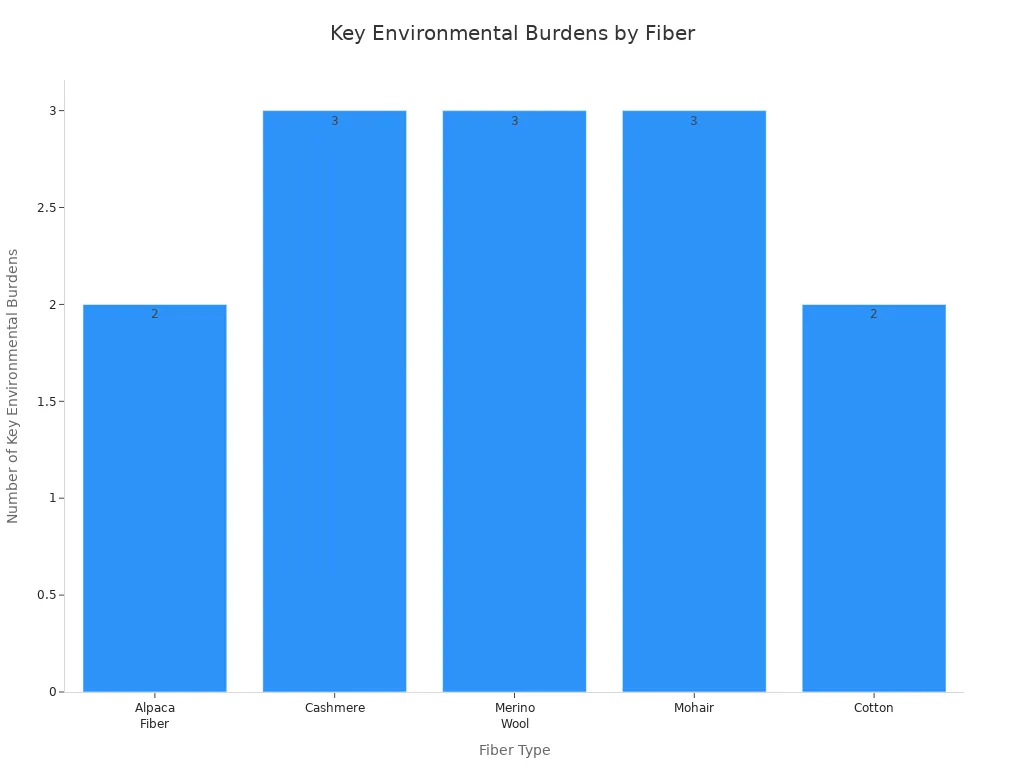
Are you looking for a Maje-Style Alpaca Jumper supplier who knows what is important? You want jumpers that are soft, look nice, and last long. Eco-friendly ways, like using natural dyes and organic stuff, are just as important as style. Good suppliers pay fair wages and keep workers safe, so each jumper is made right and looks good. Use these main ideas as your checklist when picking who to trust.
Key Takeaways
Pick suppliers who use only pure alpaca fibers. They should use eco-friendly and certified ways to make jumpers. This helps make jumpers soft, strong, and safe to wear.
Look for workers who are skilled at making jumpers. They should use old, traditional ways to make them. This helps the jumpers keep their shape and look nice for a long time.
Choose suppliers who care about the planet and people. They should use natural dyes and show where they get their materials. This helps protect nature and helps local people.
Find suppliers you can trust to give good quality every time. They should talk with you clearly and let you change things to fit your brand and style.
Work with suppliers who help customers and give clear care tips. This will help you keep your alpaca jumper nice for many years.
Maje-Style Alpaca Jumper Quality

Fiber Selection
When you choose a Maje-Style Alpaca Jumper, you want it to be soft and last long. The best jumpers use only pure alpaca fibers. These fibers keep you warm and comfortable but are not heavy. Pure alpaca fibers also make your jumper strong. They help stop fuzz and keep the shape.
You should find suppliers who follow strict rules. Some companies, like Michell, have special certifications. These include Responsible Alpaca Standard, OEKO-TEX 100, Organic Content Standard, and Global Organic Textile Standard (GOTS). These labels mean the fibers are safe and good for the planet. They also show care for people and animals. When you see these labels, you know your jumper is made the right way.
Tip: Natural ways of processing, without strong chemicals, help keep the fibers soft and strong. Always check if your supplier uses gentle methods.
Craftsmanship
How a jumper is made is very important. Skilled workers do every step, from shearing alpacas to spinning and weaving yarn. They use old methods that families have used for years. This careful work gives each jumper its special look and feel.
Artisans check every detail to make sure the jumper is strong and looks good.
Family workshops often have high standards because they care about their work.
Old weaving methods help the jumper keep its shape and style after many wears.
Alpaca fiber is tough and does not pill easily, so your jumper stays smooth and nice. If you care for it—wash gently, dry flat, and fold to store—it will look great for a long time.
Style and Design
Trend Alignment
When you look for a Maje-Style Alpaca Jumper, you want something that feels fresh and stylish. Fashion trends change every season, but some things always stay in style. Right now, people love jumpers that look smooth and feel soft. Seamless designs make the jumper flow better and feel more comfortable on your skin. You will see lots of cardigans, tunics, pullovers, and even dresses made from alpaca wool. These styles fit well with both casual and dressy outfits.
You might notice that many jumpers use a looser knit. This helps the silky alpaca fiber drape nicely. Popular designs include cable knits and flowing patterns. Most people choose neutral or soft colors, like cream, gray, or beige. These shades look elegant and never go out of style. Artisans often add special touches, like unique patterns or careful finishes, to make each jumper stand out.
Tip: Alpaca jumpers are perfect for autumn and winter. They keep you warm and cozy, and you can layer them easily for extra comfort.
Blend Options
You have many choices when it comes to fiber blends. Each blend changes how the jumper feels and works. Some blends make the jumper softer, while others add strength or make it easier to care for. Here is a table to help you see the most popular blends and what they do:
Fiber Blend | What It Adds | Best For |
|---|---|---|
Alpaca + Silk | Shine, softness, light feel | Fancy sweaters, scarves |
Royal Alpaca + Cashmere | Extra soft, plush, luxury | High-end sweaters, scarves |
Alpaca + Merino Wool | Stretch, shape, warmth | Everyday sweaters, hats |
Alpaca + Nylon | Durability, strength | Outdoor wear, socks |
Baby Alpaca + Linen | Breathable, crisp, cool | Spring/fall sweaters |
Suri Alpaca + Bamboo Viscose | Cool, silky, moisture-wicking | Light, drapey clothes |
Alpaca + Acrylic | Lower cost, easy care | Budget sweaters |
If you want a jumper that feels soft and lasts long, try blends with silk or merino wool. For something more affordable, blends with acrylic or nylon work well. Some blends, like baby alpaca with linen, are great for mild weather. You can pick the blend that fits your needs and style.
Sustainability and Ethics

Eco-Friendly Practices
You want your jumper to look nice and feel good. You also want it to be good for the earth. Many top suppliers use green ways to make jumpers. These steps help protect nature.
They use fashion methods that do not waste much. They follow the Global Reporting Initiative.
Their alpaca yarns have special eco labels.
Fair Trade means workers get fair pay and help for their towns.
Responsible Alpaca Standard shows they care for animals.
They follow OEKO-TEX 100, Organic Content Standard, and GOTS rules.
They use plant and mineral dyes, like Tarwi flower, beets, and purple corn. This means no strong chemicals.
They make jumpers in small groups to cut waste and help local workers.
Local people make the jumpers by hand. This keeps old skills alive and helps families.
Did you know? Alpaca fiber is better for nature than cotton or cashmere. Alpacas have soft feet that do not hurt the ground. They eat less food and need less water. Their wool comes in many colors. This means you do not need strong dyes. It saves water and stops pollution.
Here is a quick chart to show how alpaca fiber is different from other fibers:
Fiber Type | Environmental Impact Highlights | Key Environmental Burdens | Carbon Footprint (kg CO2e/kg fiber) | Notes |
|---|---|---|---|---|
Alpaca Fiber | Gentle grazing, less water, natural colors, durable | Methane from digestion | Less need for dyes, lasts longer | |
Cashmere | Overgrazing, high water and chemical use | Overgrazing, water, chemicals | N/A | Can damage land |
Merino Wool | More land and water, chemical treatments | Land, water, chemicals | N/A | Production uses most resources |
Mohair | High water and land use, soil loss | Water, land, biodiversity loss | N/A | Farming can hurt the environment |
Cotton | Needs lots of water and fertilizer | Water, fertilizer | N/A | Growing cotton uses most water and energy |

Sourcing Transparency
You want to know where your jumper comes from. You also want to know how it was made. Good suppliers make this clear for you. They show every step, from farm to closet. Here is what they do:
They work with small farms in Peru and Ecuador. These farms treat alpacas well.
They follow animal care rules and get checked often.
They use labels like Responsible Alpaca Standard, Fair Trade, and OEKO-TEX®.
They use tracking tools, like blockchain, to show where the fiber comes from.
Farmers get fair pay and safe jobs.
They help local towns and keep old skills alive.
The Responsible Alpaca Standard (RAS) is the best label for animal care and fair work. RAS checks that alpacas live well and land is safe. It also checks that workers are treated right. Other groups check these farms too, so you can trust the label. If you see RAS on a jumper, it meets high standards.
When you buy from a supplier who shows every step, you help honest brands. You also help animals and people. You stop fake blends and make sure your jumper is special.
Supplier Reliability
Consistency
You want a supplier who delivers the same great quality every time. When you order a jumper, you expect it to look and feel just like the last one. Reliable suppliers use strict checks at every step. They test the yarn, watch the weaving, and inspect the final product. This helps them catch mistakes before the jumper reaches you.
A good supplier keeps records of each batch. They know which farm the alpaca fiber came from and who made the jumper. This makes it easy to fix problems if they come up. You can ask for samples before you place a big order. This way, you see the quality for yourself.
Here are some signs of a consistent supplier:
They always meet deadlines.
They use the same high-quality materials.
They follow the same process for every order.
They share updates with you during production.
Tip: Ask your supplier for photos or videos of their workshop. This gives you a better idea of how they work and what you can expect.
Communication
Clear and quick communication makes everything easier. You want a supplier who answers your questions fast. If you ask about fiber types or want to see a sample, they should respond right away. Good suppliers explain their products in simple words. They tell you about their certifications and how they treat workers and animals.
Reliable suppliers stay honest with you. They tell you if there is a delay or if something changes. They work with you to solve problems. Even if you live far away, they keep in touch and make sure you feel heard.
You can spot a dependable supplier by how they talk to you:
They reply to emails or messages quickly.
They offer to send samples.
They explain their process and answer your questions.
They show proof of their ethical practices.
They want to build a long-term partnership.
When you find a supplier who communicates well, you feel more confident. You know your order is in good hands.
Wholesale and OEM Services
Bulk Orders
When you want to buy a lot of Maje-style alpaca jumpers, you need a supplier who can handle big orders. Some suppliers let you order as few as 50 pieces, while others can make thousands at once. This helps you start small or go big, depending on your needs. You get the same quality whether you order a small batch or a large one. Suppliers like Dongguan Dream Horse Clothing Co. have a strong team and advanced knitting machines. They can make up to 5,000 jumpers each week and ship them worldwide.
You can ask for a sample before you place a big order. Most suppliers finish samples in just 3 to 7 days. Once you approve the sample, they start making your full order. Production usually takes 10 to 20 days, but it can change if you order more. You also get updates during the process, so you always know what is happening.
Tip: Always ask about the minimum order quantity (MOQ) and lead times before you decide. This helps you plan better and avoid surprises.
Customization
You want your alpaca jumpers to stand out. Good suppliers offer many ways to customize your order. You can pick from over 300 Pantone colors, choose special yarn blends, and add your own logo or design. Some suppliers let you add embroidery, unique patterns, or even special packaging. You can also ask for custom neck labels and hang tags to match your brand.
Here is a quick look at what you can customize:
Customization Aspect | Details |
|---|---|
Material | Alpaca wool, cashmere, merino, cotton, blends |
Colors | 300+ Pantone shades |
Logos & Graphics | Jacquard, screen print, embroidery, foil, velvet, glitter, embossing |
Packaging | Polybag, carton, custom packaging |
Labels & Tags | Custom neck labels, hang tags |
Order Size | From 50 to thousands, depending on the item |
You do not need to worry if you have a special request. Suppliers help you from the first idea to the final product. They answer your questions, show you samples, and guide you through each step. You can even order a small batch to test your design before making a big order.
Choose your favorite yarn and color.
Add your logo or a special pattern.
Pick the packaging that fits your brand.
Get help with design and sizing.
With these options, you can create a Maje-style alpaca jumper that is truly your own.
Customer Support
Responsiveness
You want a supplier who listens and responds quickly. Good customer support makes your buying process smooth and stress-free. Top-rated alpaca jumper suppliers know this. They offer help that feels personal and ongoing. You can ask questions about designs, colors, or order sizes, and they guide you every step of the way.
You get a dedicated contact who understands your needs.
Suppliers answer emails and calls fast, so you never feel ignored.
They help you with custom orders, from picking yarn to choosing packaging.
You can request samples before you buy in bulk.
Clear policies on shipping, refunds, and product care keep you informed.
Some companies, like Llacta.com, even manage support from the United States, making it easy for you to reach out. Others, such as Alpaca Collections, have special sections just for wholesale clients. You always know where to go for help.
Quick replies and clear answers show that a supplier values your business. When you feel heard, you trust them more.
Care Guidance
Taking care of your alpaca jumper keeps it looking and feeling great. The best suppliers do not just sell you a product—they teach you how to care for it. They give you easy-to-follow care tips, so your jumper stays soft and lasts longer.
You might get a care card with your order or find tips on the supplier’s website. Here are some common care steps:
Care Step | What to Do |
|---|---|
Washing | Hand wash in cold water |
Drying | Lay flat to dry, avoid wringing |
Storing | Fold and keep in a cool, dry place |
Ironing | Use low heat if needed |
Customers often share how much they love their jumpers because they stay soft and stylish after many wears. Reviews mention that clear care instructions help them keep their jumpers in top shape. When you know how to care for your jumper, you get more value and enjoy it for years.
Good care guidance is a sign of a supplier who cares about you and your purchase.
When you look for a Maje-Style Alpaca Jumper supplier, focus on quality, eco-friendly practices, and trust. Use the checklist to pick products made from pure alpaca fibers, crafted by skilled artisans, and certified by groups like Fair Trade or OEKO-TEX 100. Choose suppliers who use natural dyes and show where their jumpers come from. You can feel good knowing your choice supports fair pay and the planet. Start your search with these steps and find a supplier you can count on!
FAQ
How do I know if my alpaca jumper is made from real alpaca fiber?
Look for labels like Responsible Alpaca Standard or OEKO-TEX 100. Ask your supplier for proof or certificates. Real alpaca jumpers feel soft, warm, and light. If you have doubts, request a sample before you buy.
Can I wash my alpaca jumper at home?
Yes, you can! Hand wash your jumper in cold water with mild soap. Lay it flat to dry. Avoid wringing or hanging. Your jumper will stay soft and keep its shape.
What makes Maje-style alpaca jumpers different from regular sweaters?
Maje-style jumpers use pure alpaca fiber and skilled craftsmanship. You get a soft, elegant look with unique patterns and finishes. These jumpers often follow the latest trends and offer more customization options.
Are alpaca jumpers good for people with sensitive skin?
Yes! Alpaca fiber feels smooth and does not itch like some wool. Many people with sensitive skin love alpaca jumpers. If you worry about allergies, ask for a sample first.
How can I order custom designs or colors?
Most suppliers offer customization. You can pick your favorite color, yarn blend, and even add your logo. Just share your ideas with the supplier. They will guide you through the process and send a sample if you want.









